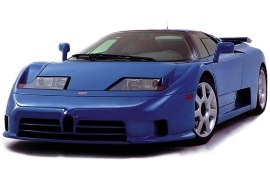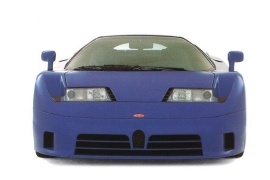BUGATTI EB 110 Models/Series Timeline, Specifications & Photos
First production year: 1991
Engines: Gasoline
Body style: Coupé (two-door)
After the Bugatti brand was reborn in the late '80s, the French brand now under Italian ownership produced, apart from the EB 110, a more powerful version named EB 110 SS.
The new owner of the Bugatti brand was the Italian entrepreneur Romano Artioli, and after he successfully launched the EB 110 exactly 110 years after the birth of the famous Ettore Bugatti in September 1991, he insisted on creating an upgraded version. Thus, in 1992, at the Geneva Motor Show, the EB 110 SS was unveiled.
Based on the same bodywork and carbon-fiber chassis as the EB 110, the SS version featured a slightly different styling. While the front fascia remained similar, with the same small horseshoe-shaped air intake in the lower part of the bumper, the area behind the doors was changed. Thus, instead of small, triangular windows, the carmaker installed aluminum panels with five round air intakes. Out back, the car featured an adjustable wing that increased the downforce at high speeds.
The interior was stripped from the luxurious items installed in the regular EB. A pair of carbon-fiber sports seats fitted with four-point harnesses reminded the occupants that the SS version was not an ordinary supercar. Moreover, the instrument cluster received a carbon fiber panel that supported the dials and gauges. Last but not least, a Momo race-inspired steering wheel completed the racy atmosphere of the supercar.
Behind the cabin, the quad-turbo V12 engine was squeezed to produce 52 more PS (51 HP), resulting in a total of 612 PS (603 HP). That oomph was still sent in all corners via a six-speed manual gearbox.
At the beginning of '90s, Bugatti built the most technologically advanced supercar in the world. It was reborn of a legendary brand, performed by a group of enthusiast engineers.
Romano Artioli gathered a group of engineers who worked together on other supercars such as the Lamborghini Miura. The design was a contest between Marcelo Gandini and other famous designers from the era. Over the development project, the design had to be changed but Gandini said no. In the end, the known designer Gianpaolo Benedini finished the project. The car featured advanced technologies made by the French helicopter manufacturer Aerospatiale, who built the carbon-fiber chassis. It was something never done before. And so was the car.
Benedini wiped off the pop-up headlights from the Gandini project, raised the front end, and included wider air-intakes on the sides plus air-vents in the front hood to increase the downforce at high speeds. On top of that, the EB110 featured an active aerodynamic system, which opened and closed air-intakes, raised and lowered the rear wing.
Inside, there was a luxury crafted interior, with wood on the dash and leather on the seats. The six-speed manual sent the torque to all four wheels, via a fixed 27:73 torque ratio. The side windows were only partially open and the scissor doors were kept from the original, Gandini, project.
The engine was a 3.5-liter quad-turbo V12. The EB110 offered what the Jaguar XJ220 promised to be, but failed to do it. The EB110 took its name from Ettore Bugatti and his 110 birthday.

